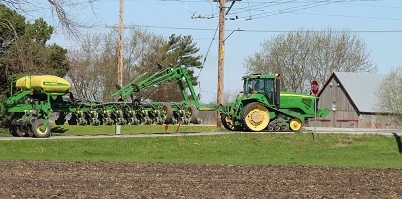Farm machinery on the road is an important part of rural life. It requires everyone’s attention and cooperation.
Farm machinery is common on rural roads, especially in the agricultural heartland, where fields are vast and extend for many miles.
Consequences of sharing the road with farm machinery
Tractors, combines and other large machines play an important role in the production of a plentiful harvest. They also support communities’ agricultural infrastructure. The coexistence between these giants and faster conventional vehicles presents unique challenges. They require patience, an understanding of safety regulations, and adherence to them.
The speed of farm machinery is usually slower than that of a road vehicle. Due to this stark contrast in speed, drivers must be more aware of their surroundings. Overtaking farm machinery requires patience since the speed of the equipment and its visibility to oncoming traffic must be carefully considered. The narrower, winding roads of rural areas accentuate the importance of caution. Drivers must anticipate farm equipment and carefully plan overtaking maneuvers.
The sheer size of the farm equipment also demands plenty of space. Tractor towing implements such as seeders or plows can occupy an extensive portion of the road, which reduces the space available for other vehicles. All road users must take a proactive approach to this problem, encouraging a spirit of cooperation and understanding. The drivers should realize that the farmers who operate these machines play a vital role in the food production process. Their presence on the roads is therefore not an inconvenience but rather a necessity.
Communication and signaling are crucial to ensuring a safe interaction between farm equipment and conventional vehicles. Farm equipment is equipped with flashing lights, reflector markings, and Slow-Moving Vehicle (SMV) emblems to warn others of their presence. It is important to recognize and obey these signals to avoid accidents and promote a peaceful sharing of roads. Drivers of farm equipment should also be careful to use the correct signals when making turns, stopping, or changing their direction of travel.

Education initiatives that target both rural and urban residents can help raise awareness about the complexities of driving with farm equipment. Informational material, public campaigns, and driver-education programs can emphasize the need for patience and caution when dealing with agricultural vehicles that are moving slowly. All road users can develop a greater sense of compassion by understanding the challenges farmers face and their vital role in supporting local economies.
Infrastructure improvements, in addition to raising awareness of the issue, can help create a more peaceful coexistence. The implementation of clear signs indicating farm equipment, widening the shoulders, and creating designated zones to allow for passing, as well as a wider shoulder, can reduce potential collisions between faster-moving traffic and slower agricultural vehicles. To ensure the safety of rural transportation, it is important to invest in roads and bridges that can support the weight and size of farm equipment.
The local authorities and law enforcement agencies play an important role in maintaining regulations relating to farm equipment on roads. Regular checks of lighting, signs, and speed limits will help create a safe environment for road users. Law enforcement officers can be more supportive and sympathetic if they are educated about the challenges farmers face on the roads. This will help them strike a better balance between the safety of the operation and practical requirements.
Conclusion
To conclude, the responsibility of sharing roads with farm equipment is shared by all road users. This requires cooperation, patience, and awareness. The agricultural industry is still the foundation of many rural communities. Therefore, it’s important to integrate farm machinery safely onto the roads to maintain our food supply. We can foster a culture of road sharing that is respectful, educated, and based on improved infrastructure. This will ensure a harmonious and safer coexistence between commuters and agricultural needs.
